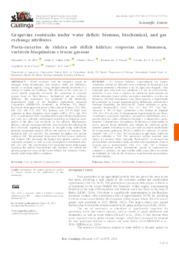Grapevine rootstocks under water deficit: biomass, biochemical, and gas exchange attributes.
Grapevine rootstocks under water deficit: biomass, biochemical, and gas exchange attributes.
Autoria: SILVA, A. G. da; FELINTO FILHO, E. F.; ULISSES, C.; MUSSER, R. dos S.; COSTA, C. dos S. R.; CHAVES, A. R. de M.; LEAO, P. C. de S.
Resumo: Water resources used for irrigation should be managed using technologies that improve water use efficiency, mainly in semiarid regions. Using drought-tolerant rootstocks is a strategy to handle this challenge. The objective of this study was to select suitable grapevine rootstocks for cultivation in semiarid regions based on their biomass, biochemical, and gas exchange attributes. The experiment was conducted at the Bebedouro Experimental Field of the Brazilian Agricultural Research Corporation (EMBRAPA Semiarid), in Petrolina, PE, Brazil. Rootstocks from grapevine plants of the cultivars Paulsen 1103, SO4, IAC 313, IAC 572, IAC 766, Ramsey, and 101-14 MgT were subjected to three irrigation water depths (100%, 50%, and 20% ET0). A randomized block experimental design with four replications was used, in a split-plot arrangement consisting of irrigation water depths in the plots and rootstocks in the subplots. Biochemical, biomass, and gas exchange attributes were assessed for selecting the best rootstocks regarding tolerance to drought using multivariate principal component analysis (PCA) and analysis of variance. The rootstocks IAC 313 and IAC 766 presented the highest root proline synthesis; IAC 766 presented better result for leaf sucrose synthesis; and Paulsen 1103 presented the highest leaf proline synthesis and carotenoid contents, as well as total chlorophyll-to-carotenoid ratio. IAC 313, IAC 766, and Paulsen 1103 presented better performance regarding the studied characteristics and, therefore, are suitable for growing grapevine crops in the Lower Middle São Francisco Valley, mainly under water deficit conditions.
Ano de publicação: 2024
Tipo de publicação: Artigo de periódico
Unidade: Embrapa Semiárido
Palavras-chave: Biomassa, Déficit hídrico, Osmorreguladores, Porta Enxerto, Rootstocks, Uva, Videira, Viticulture, Vitis, Water resources
Observações
1 - Por padrão são exibidas publicações dos últimos 20 anos. Para encontrar publicações mais antigas, configure o filtro ano de publicação, colocando o ano a partir do qual você deseja encontrar publicações. O filtro está na coluna da esquerda na busca acima.
2 - Para ler algumas publicações da Embrapa (apenas as que estão em formato ePub), é necessário ter, no celular ou computador, um desses softwares gratuitos. Sistemas Android: Google Play Livros; IOS: iBooks; Windows e Linux: software Calibre.
Acesse outras publicações
Acesse a Base de Dados da Pesquisa Agropecuária (BDPA) para consultar o acervo completo das bibliotecas da Embrapa.

